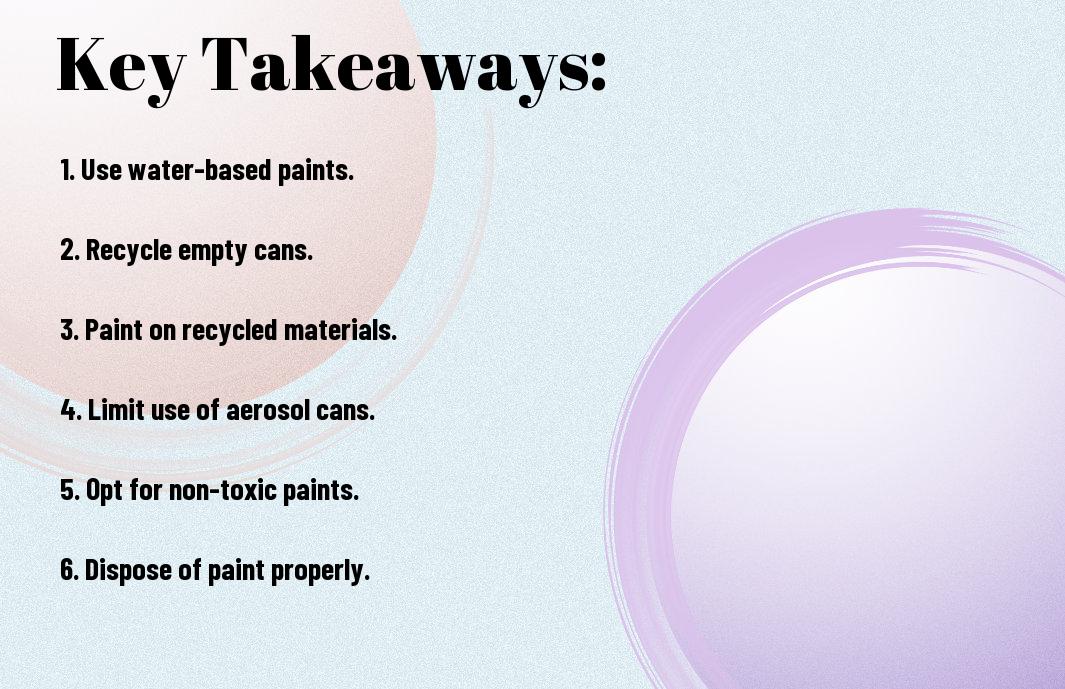Over the years, the art world has become increasingly conscious of the environmental impact of its practices. With respect to spray paint art, there are several eco-friendly measures you can take to minimize your carbon footprint. By opting for water-based or low-VOC spray paints, using recycled materials, and properly disposing of chemicals, you can create stunning works of art while also caring for the planet. Let’s explore some sustainable practices that you can incorporate into your spray paint art techniques.
Key Takeaways:
- Use eco-friendly spray paint: Opt for water-based or low VOC spray paint to reduce harmful emissions and promote better air quality.
- Repurpose materials: Utilize recycled or repurposed canvases and found objects for your spray paint art to reduce waste and promote sustainability.
- Clean up responsibly: Properly dispose of empty spray paint cans and packaging, and consider investing in a reusable paint respirator to minimize environmental impact.
Benefits of Eco-Friendly Practices
Reducing Environmental Impact
While practicing eco-friendly spray paint art techniques, you significantly reduce the environmental impact of your artwork. Traditional spray paints contain harmful chemicals that contribute to air and water pollution. By opting for eco-friendly paint options, you are choosing a more sustainable approach that minimizes these negative effects on the environment. Additionally, eco-friendly paints often come in recyclable packaging, further reducing waste.
Improving Health and Safety
Reducing your exposure to toxic chemicals is crucial for your health and safety when creating spray paint art. Practices such as using water-based or low-VOC (volatile organic compound) paints instead of conventional aerosols can greatly improve the air quality in your workspace. These eco-friendly alternatives emit fewer harmful fumes, making the environment safer for you to breathe in while also minimizing the risk of skin irritation or respiratory issues associated with inhaling toxic paint particles.
It is important to prioritize your health and safety while engaging in spray paint art. By choosing eco-friendly practices, you not only protect yourself from potential health risks but also contribute to a cleaner and safer environment for everyone.

Choosing Eco-Friendly Spray Paints
Some eco-friendly practices in spray paint art involve selecting paints that are better for the environment. When choosing spray paints, there are several factors to consider to make your art more sustainable. Here are some tips to help you choose eco-friendly spray paints:
Look for Low-VOC Formulas
On your search for eco-friendly spray paints, one key factor to consider is the VOC (volatile organic compound) content. VOCs are harmful chemicals that can be released into the air and contribute to air pollution. By opting for spray paints with low-VOC formulas, you can reduce your environmental impact and create art with fewer harmful emissions.
Opt for Water-Based Paints
When opting for spray paints, consider choosing water-based formulas over traditional solvent-based ones. Water-based paints have lower VOC levels and are less harmful to both your health and the environment. They also tend to have less odor, making them a more pleasant option for indoor and outdoor use. Water-based paints are easy to clean up with soap and water, reducing the need for harsh chemicals.
Paints What’s more, water-based spray paints come in a wide range of colors and finishes, allowing you to express your creativity while being mindful of the planet. By switching to water-based paints, you can make a positive impact on the environment without compromising the quality of your artwork.
Consider Plant-Based Paints
Look for spray paints made from plant-based ingredients, such as pigments derived from plants like algae or vegetables. These eco-friendly paints are biodegradable and have minimal environmental impact, making them a sustainable choice for your spray paint art projects. Plant-based paints also tend to have lower VOC levels, making them a safer and greener option for both you and the planet.
Choosing plant-based paints for your artwork shows your commitment to sustainability and environmental consciousness. By incorporating these eco-friendly alternatives into your spray paint art, you can create beautiful pieces while reducing your carbon footprint and promoting a healthier planet for everyone.
Preparing Your Workspace
Ventilation and Air Quality
Your health and safety are paramount when engaging in spray paint art. Adequate ventilation in your workspace is crucial to ensure the dispersion of fumes. Always work in a well-ventilated area, such as outdoors or a space with open windows and fans. This will help reduce your exposure to harmful chemicals and maintain good air quality.
Protecting Your Skin and Eyes
Your skin and eyes are sensitive to the chemicals present in spray paint. It’s imperative to wear protective gear such as gloves, long-sleeved clothing, and goggles to shield yourself from potential harm. Additionally, consider using a face mask to prevent inhaling fumes and particles that can irritate your respiratory system.
Another important aspect of protecting your skin and eyes is to wash your hands and any exposed areas thoroughly after completing your artwork. This helps remove any paint residue and reduces the risk of skin irritation or accidental contact with eyes.
Using Reusable Drop Cloths
One eco-friendly practice in spray paint art is using reusable drop cloths to protect your workspace from paint splatters and spills. Instead of disposable options, opt for durable materials like canvas or old sheets that can be easily cleaned and reused for future projects. This not only reduces waste but also saves you money in the long run.
Using reusable drop cloths not only helps in maintaining a cleaner workspace but also contributes to the sustainability of your art practices. By investing in quality materials that can be used repeatedly, you are minimizing your environmental impact and promoting a more eco-conscious approach to your art.
Sustainable Canvas Options
Repurposing Old Materials
Keep in mind that one of the most eco-friendly practices in spray paint art is to repurpose old materials for your canvas. Instead of buying new canvas supplies, look around your house or local thrift stores for old canvases, pieces of wood, cardboard, or even fabric that you can paint on. By reusing these materials, you not only reduce waste but also give a new life to items that would have otherwise been discarded.
Using Recycled Canvas
The use of recycled canvas is another sustainable option for your spray paint art. When purchasing canvas, opt for those made from recycled materials. These canvases are often made from reclaimed cotton or polyester fibers, reducing the environmental impact of producing new canvas materials. Make sure to check the product description or labels to ensure you are choosing a recycled canvas option for your artwork.
The use of recycled canvas not only minimizes the demand for new materials but also contributes to closing the loop on the production and disposal of art supplies. By supporting recycled canvas products, you are promoting a more sustainable art industry overall.
Creating Your Own Canvas from Natural Fibers
It is also possible to create your own canvas from natural fibers for your spray paint art. Options such as hemp, jute, or even recycled paper can be used to make your canvas. By using natural fibers, you are choosing a renewable and biodegradable material for your artwork, reducing the environmental impact of your creative process.
With the increasing popularity of sustainable practices in art-making, many artists are exploring different ways to create their canvases from natural fibers. Experiment with different materials to find the one that best suits your style and preferences while aligning with your eco-friendly values.

Minimizing Waste and Recycling
Reducing Paint Waste
Despite your best efforts, some paint waste is inevitable in the art of spray paint. One way to reduce waste is by planning your artwork in advance and being mindful of the amount of paint you use. Avoid spraying more paint than necessary and try to work in layers to build up colors gradually. By using the right techniques, you can minimize excess paint and create stunning pieces without unnecessary waste.
Recycling Spray Paint Cans
Minimizing waste also means responsibly disposing of empty spray paint cans. One eco-friendly practice is to recycle your empty cans at designated recycling centers or facilities that accept aerosol cans. Recycling helps prevent these cans from ending up in landfills and reduces the environmental impact of your art. Remember to check with your local recycling guidelines to ensure proper disposal.
With recycling, empty spray paint cans can be melted down and used to create new products, reducing the need for raw materials and energy. By taking the extra step to recycle your cans, you not only contribute to a greener planet but also support the circular economy by giving materials a second life.
Repurposing Leftover Paint
With every finished artwork, there may be leftover paint that you don’t want to go to waste. One eco-friendly practice is to repurpose this excess paint for future projects. You can mix leftover colors to create new shades, use them for background layers, or even experiment with different techniques on practice surfaces. By getting creative with your leftover paint, you can minimize waste and expand your artistic possibilities.
Paint can also be repurposed for other DIY projects around your home or studio. From painting furniture to adding color to décor items, leftover spray paint can be a versatile resource for your creative endeavors. By thinking outside the canvas, you can reduce waste, save money on new supplies, and add a personal touch to everyday items.
Creative Techniques for Reducing Waste
Stenciling and Masking
Many eco-friendly practices in spray paint art involve reducing waste while creating beautiful pieces. With stenciling and masking techniques, you can minimize overspray and control where the paint goes. By using stencils made from recycled materials or masking off areas you don’t want to paint, you can cut down on the amount of excess paint that ends up wasted.
Using Multi-Colored Spray Paints
One creative way to reduce waste in your spray paint art is by using multi-colored spray paints. Instead of using multiple cans of single-colored paints, opt for multi-colored spray paints that offer a variety of shades in one can. This not only saves you money and space but also reduces the number of empty cans that end up in landfills.
One popular option is Montana Gold’s Marble Effect spray paint, which contains a combination of colors in one can. This innovative product allows you to create stunning gradients and blends without the need for multiple cans, minimizing waste in the process.
Creating Texture with Natural Materials
Creating texture in your spray paint art can add depth and interest to your pieces. Instead of relying solely on spray paint for texture, consider incorporating natural materials like leaves, twigs, or fabrics into your artwork. By pressing these materials onto the wet paint and then peeling them off, you can create unique textures that are eco-friendly and visually appealing.
To further reduce waste, you can source these natural materials from your surroundings, such as fallen leaves in a park or twigs from your backyard. Not only does this add a personal touch to your art, but it also promotes sustainability by utilizing materials that would otherwise go to waste.

Conclusion
Ultimately, incorporating eco-friendly practices into your spray paint art can help reduce your environmental impact and contribute to a healthier planet. By using water-based or non-toxic paints, choosing recycled or biodegradable surfaces, and properly disposing of waste materials, you can create beautiful art while being conscious of the environment.
Keep in mind, the choices you make as an artist can make a difference in the world around you. By embracing sustainability in your creative process, you can showcase your talent while also promoting a more eco-friendly approach to art. Let your passion for spray paint art inspire others to make environmentally conscious decisions in their own artistic endeavors.
Q: What are some eco-friendly practices in spray paint art?
A: To practice eco-friendly spray paint art, consider using water-based or low-VOC (volatile organic compounds) spray paints instead of traditional aerosol paints. These paints have less harmful chemicals and are better for the environment.
Q: How can I reduce waste while creating spray paint art?
A: To reduce waste, try to use up all the paint in the can before disposing of it properly. You can also repurpose old materials like cardboard or newspaper as canvases for your art to minimize the use of new resources.
Q: Are there any sustainable alternatives to traditional spray paint for art?
A: Yes, there are alternative eco-friendly options such as paint pens, markers, or even natural paints made from ingredients like plant-based dyes. These options are less harmful to the environment and can still create beautiful artwork.


